I’ve befriended many Harley owners over the years, and have met even more while at various events or when I’m out for a ride. Yet despite the number of Harley fans and loyalists I encounter, it never ceases to surprise me how few of them either know very little about, or haven’t ever heard of,Harley-Davidson’s line of in-house customs known as Custom Vehicle Operations, or CVO for short.
Crafted from existing standard model Harleys, a CVO is adorned with a laundry list of Harley’s own aftermarket goodies, as well as possessing a number of items or features unique to each model.
CVOs are notably pricier than the standard models they’re derived from, but by comparison to many high-end, high-priced cruisers from independent shops with low-volume production, the CVOs offer some serious value. Attempting to build something close to a CVO one piece at a time would lead to a sum total cost well beyond a CVO’s MSRP.
And in terms of value, what revs most folks’ engines is getting more than what was bargained for, especially when the deal nets you something on the order of two-for-one. The $29,699 Harley-Davidson CVO Softail Convertible is just such a two-for-one deal.
Model-year 2012 is the third year for the Softail Convertible in the CVO lineup. When it first surfaced in 2010 we discovered how crafty and practical Harley could get. With a few twists and turns of release knobs and latches this bike transforms from stripped-down stylin’ cruiser to destination-driven touring bike by way of its quick-release windshield, saddlebags and passenger pillion with backrest.
The Convertible’s quick-release components are so well integrated into the bike’s overall styling that when removed there’s almost no indication the bike was wearing saddlebags and a backrest only minutes prior. Even the passenger saddle removes lickity split by way of a simple knurled knob. All that’s left in the passenger seat’s absence is a set of stylish ribs, for lack of a better term, that keep the top of the rear fender from suffering abrasion by the underside of the passenger seat. These protective bumpers look like intentional design elements made to enhance the fender’s styling, and wouldn’t lead most unsuspecting observers to think they’re anything other than decorative.
This example of a detail ¬– how the bike looks with the pillion removed – speaks to what’s at the core of CVO motorcycles: ultimate attention to the little things, not just here or there, but in every aspect of the motorcycle with which a rider might interact.
The Convertible is largely the same bike it was when it first entered the CVO family, but for 2012 Harley continued to refine a few of the bike’s touring elements.
After listening to customer feedback Harley decided to increase the windshield’s height by approximately 1.0-inch and width by 2.0 inches, while also adding venting and adjustable lower wind deflectors. According to Harley, this new taller and wider screen eliminates a significant amount of wind pressure on the rider’s head, as well as reducing turbulence in the cockpit. Considering the screen’s modest size it does a good job of keeping most of the windblast away, with only a moderate amount of buffeting during freeway speeds.
Although the windshield employs Harley’s tool-less attachment system, it’s nevertheless a little intimidating the first few times you attempt to gently ease the screen from the handlebar and the fork. My trepidation stemmed from not wanting to damage the windshield’s integrated speaker system wiring. However, once the speaker wire is easily disconnected, all that’s necessary to remove the screen is a firm pull. Replacing the screen requires some finessing to line up the attachment points, but after a half-dozen or so practice runs the whole process is pretty effortless.
| 2012 CVO Convertible: Harley Treats on a CVO | |||||||||||||||||||||||||||||||||||
|
Once the shield is off, the next touring-type bits to go are the saddlebags and, if you wish, the passenger backrest. Pop open the lockable saddlebag lids, twist a pair of clearly marked dials and you’re bag-less in seconds. The dual levers holding on the backrest require minimal effort and a handful tick-tocks on the clock before the saddle is liberated of the backrest.
The first time I stripped the Convertible of its touring accoutrements I had to giggle at how quickly and painlessly I had transformed the bike from long-weekend tripper to Saturday night cruiser.
Other than the CVO Electra Glide, the Convertible is the only other CVO to receive the Road Tech Zumo 660; and like on the Electra, a rider can operate the Convertible’s included iPod nano menus through the Zumo. Turn-by-turn driving commands from the navi system will play through the dual 3.5-inch 2-way speakers nestled at the base of the windshield.
Of the four CVO bikes for 2012, the Convertible is the only the one that isn’t built from a touring platform. Where the other CVOs have bodywork and fairings that conveniently hide unsightly wiring, hoses and such, the Softail-based Convertible has precious few places to conceal the necessary but ugly stuff. Since ABS is standard to all CVOs great care was taken to preserve the Convertible’s clean custom-bike styling by creating separate ABS modulators for the front and rear wheels, with the front ABS unit tucked neatly out of sight behind the upper fork cover. Here again we have more thoughtful details and special attention given to the CVOs.
Motivating all CVOs is Harley’s 110 cubic-inch Screamin’ Eagle V-Twin that produces a claimed 105 ft-lbs of torque. In the Convertible this engine is the 110B, meaning the big Twin is counterbalanced in order to smooth out power pulses and vibes in the rigid-mount frame (all Softails are rigid mounts). Throttle response is excellent from Harley’s well-sorted EFI, as usual. There’s plenty of power on tap in the Screamin’ Eagle, and the minimalist air cleaner cover allows the rider to hear the engine snort and gulp air through the intake as the big Twin breathes deep.
“Our bike spat out 79.5 horsepower at 4750 rpm when strapped to the Gene Thomason Racing dyno,” says Duke of our mechanically identical 2011 tester, “but it’s the torque curve that is most impressive. It’s twisting out more than 90 ft-lb at just 2250 rpm, peaking just 500 revs later with 97.2 ft-lb. “
The 6-speed gearbox in this particular Harley struck me as a little less refined than what I’m used to from the numerous Harleys I’ve ridden.
“All CVOs are given hydraulic actuation,” Duke notes, “which reduces lever effort for the stronger clutch springs necessary with the TC110. But the larger-diameter grips on the Convert effectively bring the engagement point close to the bar, enough to cause the clutch to slightly drag when fully pulled in. This unfortunately delivers abrupt clutch engagement and makes neutral difficult to access when at a stop.”
The ingenuity and slickness of the Convertible’s quick-release touring-oriented add-ons, as well as its big engine, premium paint and chrome, and custom-bike aura are all standouts. Perhaps most immediately impressive to me, though, was the Convertible’s ride quality – for reasons good and a little less than good.
The other, positive, facet of the Convertible’s ride quality is how remarkably comfortable it is.
Although the Converti’s 3.3 inches of rear suspension travel is anywhere from 0.3 to 1.0 inch less than other Softail models, the Convertible’s ride is otherwise plush over most bumps. Front-end damping gobbled up most road imperfections so well I found myself wishing this front suspension was standard on all Harleys. Joining the well-damped hidden shocks in buffering the rider from the road is the thickly padded, supple seat – for both rider and passenger. Let’s hear, one more time, for the extras given to the CVOs.
Although the Convert has only a single-disc front brake setup, it uses high-end components like a Brembo caliper and braided-steel lines deliver good feel when retarding speed. HDLAN CAN/bus switchgear debuted in 2011, and the switches require less travel to activate and are less springy, “offering a tactile improvement in response and feel,” according to Duke. “Its self-canceling turn signals are among the best and most sophisticated in the biz, always canceling reliably quickly. This is a good thing, because the signal-indicator light at the bottom of the gauge pack isn’t easy to see. And its cruise control works well and is a real benefit when doing longer trips. “
During my first day with the Convertible more than one casual passerby admired this top-shelf Harley. And a couple folks even verbalized how impressed they were with the bike’s attractiveness and features. Surely, then, if these people – presumably not riders by my guess – can get sucked into the gravitational pull of a CVO’s appeal, why not more Harley enthusiasts?
“Cruising down city streets aboard the Soft-‘Vert, your eyes will be drawn to window panes as pedestrians swivel their necks checking to see who is rumbling past,” Duke relates. “The deep exhaust tone is about perfect to my ears, disturbing the peace only to tolerable levels without exceeding them.”
Since each year the numbers of CVO models are limited (and only a fraction of Harley’s annual total production volume) it’s understandable – to a point – how seemingly so few riders are aware of CVO. However, Custom Vehicle Operations is now in its 14th year, so take note, Harley enthusiasts looking to trade up: If you’ve dreamt of owning a custom cruiser but didn’t want to stray outside the Harley realm, CVO may have just what you need.
| By the Numbers | |
| Price | $26,699 |
| Engine Type | V-Twin |
| Displacement | 110 cubic inches |
| Bore x Stroke | 4.0 " x 4.38" |
| Compression | 9.15:1 |
| Torque | 105 ft-lbs (claimed) |
| Frame | Steel-Tube |
| Wheelbase | 64.2" |
| Rake/Trail | 32.0-degrees/5.8" |
| Front Suspension | 41.3mm conventional fork w/5.1" travel |
| Rear Suspension | Hidden, horizontal-mounted coil-over w/3.3" travel |
| Front/Rear Wheels | 18-inch/18-inch |
| Tires | 130/70 x 18 Front, 200/50 x 18 Rea |
| Front Brakes | Single 4-pistons caliper w/292mm roto; ABS |
| Rear Brakes | Single 2-piston caliper w/292mm rotor; ABS |
| Fuel Capacity | 5.0 U.S. gal |
| Weight | 788 lbs Running Order |
| Seat Height | 26.2" |
Related Reading
2012 Harley-Davidson CVO Models Review
2011 Harley-Davidson CVO Road Glide Ultra Review
2011 Harley-Davidson CVO Street Glide Review
2011 Harley-Davidson Blackline Softail Review
2010 Harley-Davidson Electra Glide Ultra Limited Review
2010 Harley-Davidson CVO Model Line-Up Preview
All Things Harley-Davidson on Motorcycle.com
All Things Cruiser on Motorcycle.com
All Things Touring on Motorcycle.com
 8:13 PM
8:13 PM
 Chiken Joe
Chiken Joe


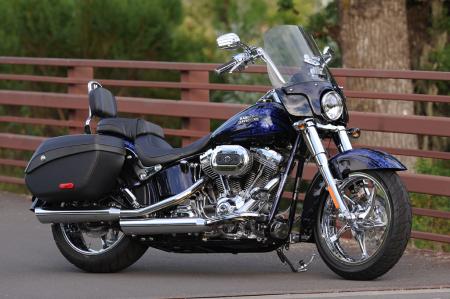
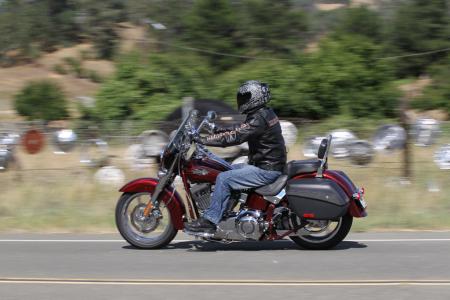
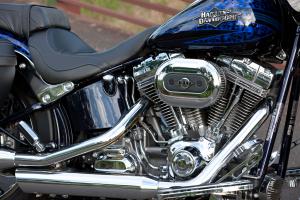
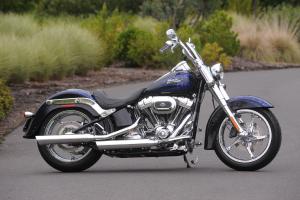
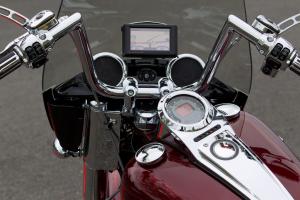
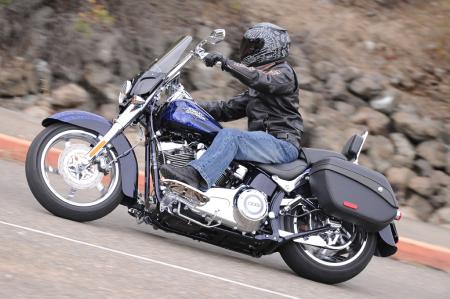
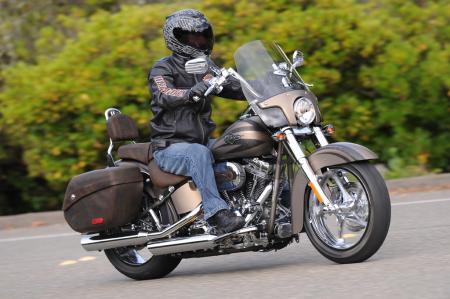
 Posted in:
Posted in: 







0 comments:
Post a Comment